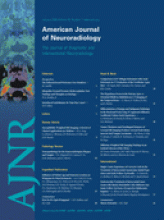Research ArticleHead and Neck Imaging
Differentiation of Benign and Malignant Pathology in the Head and Neck Using 3T Apparent Diffusion Coefficient Values: Early Experience
A. Srinivasan, R. Dvorak, K. Perni, S. Rohrer and S.K. Mukherji
American Journal of Neuroradiology January 2008, 29 (1) 40-44; DOI: https://doi.org/10.3174/ajnr.A0743
A. Srinivasan
R. Dvorak
K. Perni
S. Rohrer

References
- ↵
- ↵Sumi M, Sakihama N, Sumi T, et al. Discrimination of metastatic cervical lymph nodes with diffusion-weighted MR imaging in patients with head and neck cancer. AJNR Am J Neuroradiol 2003;24:1627–34
- ↵Habermann CR, Gossrau P, Graessner J, et al. Diffusion-weighted echo-planar MRI: a valuable tool for differentiating primary parotid gland tumors? Rofo 2005;177:940–45
- ↵
- ↵
- ↵
- Szafer A, Zhong J, Gore JC. Theoretical model for water diffusion in tissues. Magn Reson Med 1995;33:697–712
- ↵Spuentrup E, Buecker A, Adam G, et al. Diffusion-weighted MR imaging for differentiation of benign fracture edema and tumor infiltration of the vertebral body. AJR Am J Roentgenol 2001;176:351–58
- ↵Maeda M, Kato H, Sakuma H, et al. Usefulness of the apparent diffusion coefficient in line scan diffusion-weighted imaging for distinguishing between squamous cell carcinomas and malignant lymphomas of the head and neck. AJNR Am J Neuroradiol 2005;26:1186–92
- ↵Vandecaveye V, de Keyzer F, Vander Poorten V, et al. Evaluation of the larynx for tumour recurrence by diffusion-weighted MRI after radiotherapy: initial experience in four cases. Br J Radiol 2006;79:681–87
- ↵
- ↵
In this issue
Advertisement
A. Srinivasan, R. Dvorak, K. Perni, S. Rohrer, S.K. Mukherji
Differentiation of Benign and Malignant Pathology in the Head and Neck Using 3T Apparent Diffusion Coefficient Values: Early Experience
American Journal of Neuroradiology Jan 2008, 29 (1) 40-44; DOI: 10.3174/ajnr.A0743
0 Responses
Jump to section
Related Articles
- No related articles found.
Cited By...
- Diffusion-Weighted Imaging of the Head and Neck: Influence of Fat-Suppression Technique and Multishot 2D Navigated Interleaved Acquisitions
- Diffusion-Weighted Imaging of Orbital Masses: Multi-Institutional Data Support a 2-ADC Threshold Model to Categorize Lesions as Benign, Malignant, or Indeterminate
- Differentiation of Recurrent Tumor and Posttreatment Changes in Head and Neck Squamous Cell Carcinoma: Application of High b-Value Diffusion-Weighted Imaging
- Prediction of Nodal Metastasis in Head and Neck Cancer Using a 3T MRI ADC Map
- Neuroradiology Back to the Future: Head and Neck Imaging
- Biologic Imaging of Head and Neck Cancer: The Present and the Future
- MR Evaluation of Sinonasal Angiomatous Polyp
- Apparent Diffusion Coefficient Mapping for Sinonasal Diseases: Differentiation of Benign and Malignant Lesions
- Diffusion MR Imaging Features of Skull Base Osteomyelitis Compared with Skull Base Malignancy
- Imaging Characteristics of Primary Laryngeal Lymphoma
- Non-Gaussian Analysis of Diffusion-Weighted MR Imaging in Head and Neck Squamous Cell Carcinoma: A Feasibility Study
- Utility of the K-Means Clustering Algorithm in Differentiating Apparent Diffusion Coefficient Values of Benign and Malignant Neck Pathologies
- Can Quantitative Diffusion-Weighted MR Imaging Differentiate Benign and Malignant Cold Thyroid Nodules? Initial Results in 25 Patients
This article has not yet been cited by articles in journals that are participating in Crossref Cited-by Linking.
More in this TOC Section
Similar Articles
Advertisement











